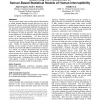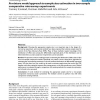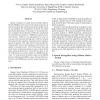128 search results - page 18 / 26 » Hydrological models are so good, do we still need data |
KDD
2009
ACM
14 years 8 months ago
2009
ACM
Collaborative filtering is the most popular approach to build recommender systems and has been successfully employed in many applications. However, it cannot make recommendations ...
CHI
2004
ACM
14 years 8 months ago
2004
ACM
Current systems often create socially awkward interruptions or unduly demand attention because they have no way of knowing if a person is busy and should not be interrupted. Previ...
BMCBI
2008
13 years 7 months ago
2008
Background: Choosing the appropriate sample size is an important step in the design of a microarray experiment, and recently methods have been proposed that estimate sample sizes ...
COMPUTER
2002
13 years 7 months ago
2002
rs use models or abstractions that hide low-level implementation details. Various kinds of representations such as data models, state-transition models, and dataflow models can hel...
ICPR
2006
IEEE
14 years 8 months ago
2006
IEEE
Speech recognition is usually based on Hidden Markov Models (HMMs), which represent the temporal dynamics of speech very efficiently, and Gaussian mixture models, which do non-opt...



